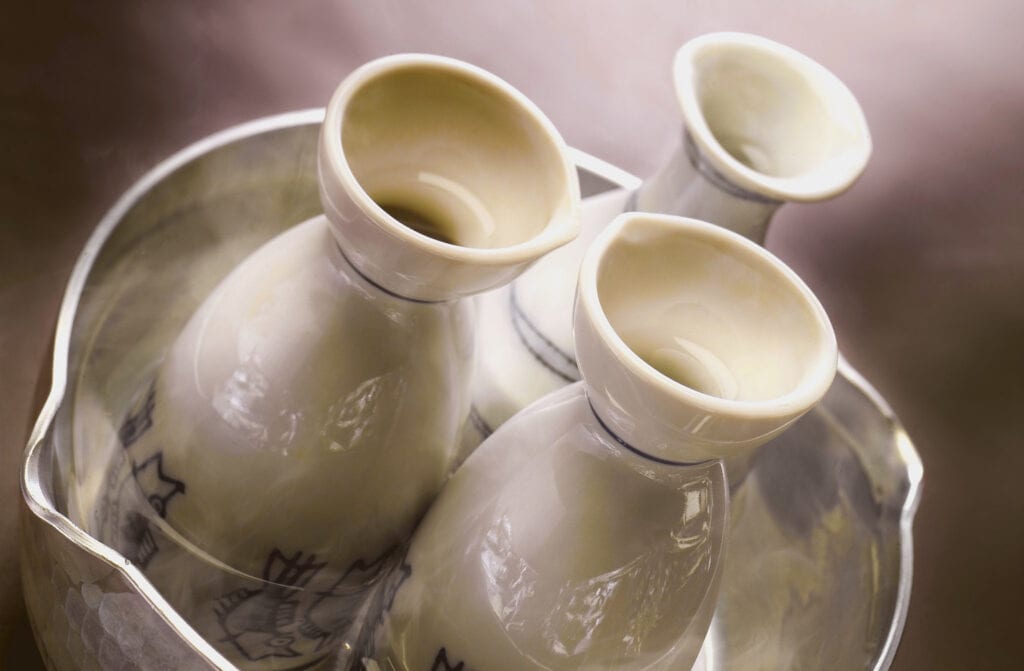How to drink Japanese sake?
One of the most frequently asked questions in connection with Sake refers to the drinking temperature of sake. Whether sake is tasted warm or cold depends on the quality level of the sake and personal preferences.
The recommended drinking vessels for sake are similar. The options vary depending on the occasion and, above all, the drinking temperature. In addition to traditional porcelain cups and wooden vessels, thin-walled glasses are also served, especially for premium sake drunk cold. Nosing glasses, for example, are ideal.
What drinking temperature should sake be?
The question of the perfect drinking temperature for sake cannot be answered across the board.
Because whether a sake is better served cold or warm depends on many different factors. As a rule, high-quality premium sakes tend to be served cold. However, full-bodied and stronger sakes are also a real treat when served warm.
Furthermore, the mood at the moment of tasting plays a weighty role, as does the season - typical of Japanese culture and Japanese cuisine, which are very connected with nature and season.
However, this does not mean that all sake should be enjoyed warm in winter, as some varieties simply taste better cold.
This is also evident by the fact that while all sake can be drunk cold, not all sake is suitable for drinking warm or even hot.
The correct drinking temperature of sake is an essential factor in bringing out the respective character and aroma best. The best drinking temperature for a particular sake depends first and foremost on the Sake category from.
What kind of sake do you drink warm?
When it comes to the drinking temperature of sake, a very decided distinction is made between warm and hot.
Sake that is to be enjoyed warm should have a temperature of 30 to a maximum of 50 degrees. Unlike cold sake, warm sake is traditionally drunk not from glasses, but from porcelain cups or ceramic vessels. It is also important to warm it carefully, which is best done using a water bath.
Of the different types of sake are particularly suitable for heating Taruzake, Yamahai, Kimoto and Junmai as well as Junmai Ginjō. To perfectly emphasize the particular flavor, the exact temperature is not unimportant.
How important this is, is also shown by the exact classification of the degrees of heat for sake. Thus, all degrees of heat have their own names, which describe the respective temperature. For example, when a sake is drunk at 30 degrees, it is referred to as Hinata-kan (日向燗), which roughly means "warm as in the sun." This degree of heat is credited with bringing out the flavors of sweetness and umami very subtly. Another popular degree of heat is Jō-kan (上燗), which is 45 degrees and is considered the highest degree of heat that maintains balance in flavor.
Which sake do you drink hot?
The only sake that is suitable to be drunk hot is the Sake category Futsūshu - also known as standard sake. Hot sake is sake that is heated to a temperature of at least 50 degrees, loses balance significantly due to this heat, and can be very stimulating due to the higher alcohol it contains. This applies to sake drunk at the Atsu-kan (熱燗) degree of heat, that is, hot at 50 degrees. Sake served at the Tobikiri-kan (飛び切り燗) heat level extra hot, on the other hand, is heated up to 60 degrees and is considered very spicy and dry.
Which sake do you drink cold?
In principle, any sake can be drunk cold. But especially premium sake of the varieties Ginjō, Junmai Ginjō, Daiginjō and Junmai Daiginjō develop their special flavor nuances only when served cool.
Of course, the detail-oriented Japanese also distinguish between different degrees of cold at which sake is drunk. Jō-on (常温), for example, refers to a room temperature of 20 to 25 degrees. The advantage of this temperature is a clear prominence of the respective aromas and flavor elements. If you appreciate a floral and fruity taste in sake, the temperature Hana-hie (花冷え), which is 10 degrees, is recommended, as the mentioned flavors are emphasized. Fittingly, Hana-hie also means "cool as flowers".
More in our detailed article about sake drinking temperature.
From which vessels can you drink sake?
Traditionally, sake is often served in ceramic vessels. However, glasses and containers made of wood are also used for drinking sake. When sake is drunk cold, it is best to use glasses, as they most effectively enhance the flavors of premium sake served cool. Warm sake, on the other hand, is most comfortable drunk from ceramic mugs or porcelain vessels.
What sake do you drink from a glass?
Traditionally, sake is often served in ceramic vessels. However, glasses and containers made of wood are also used for drinking sake. When sake is drunk cold, it is best to use glasses, as they most effectively enhance the flavors of premium sake served cool. Warm sake, on the other hand, is most comfortable drunk from ceramic mugs or porcelain vessels.
What kind of sake do you drink from porcelain or ceramic vessels?
Of course, you can also drink cold sake from traditional ceramic or porcelain cups and bowls, which are actually more suitable for warm sake. These vessels, known in Japanese as ochoko (お猪口), are in fact very versatile and suitable for both cold and warm sake.
In fact, they are the best option for warm sake, as they retain heat well and support the natural aroma of heated sake. Complementary to ceramic mugs, porcelain or ceramic decanters are often used in the context of warm sake. Known as tokkuri (徳利), these vessels allow sake to be heated in a water bath and then poured.
Another porcelain vessel worth mentioning for enjoying sake is known as Kikichoko (唎猪口) and is primarily used to taste sake professionally. Thus, there are blue circles at the bottom of the white porcelain cups to judge the transparency of the sake in question. Known in Japanese as Ja-no-me (蛇の目), meaning "snake eye", this is one of the most common sake symbols of all.
How to drink sake from a wooden vessel?
Masu (枡) is the Japanese term for measuring cups that are used, among other things, for portioning rice. According to tradition, they are also used for drinking sake. A masu has a capacity of 180 ml. Masu served not only its original function as a tool for measuring grain and liquids. They are also used as vessels for offerings to the gods. For this reason, they are often used for festive occasions. The square wooden vessels are available lacquered or unlacquered and due to their shape require some skill when drinking.
Properly sake is drunk from the flat part of the square masu and not from the corner. In Japan, there is also the custom of placing a small glass in the masu and pouring sake into it until it overflows and the masu cup is filled. Masu cups or kimasu cups, as the unpainted variety is called, are primarily for tasting cold sake.
How can the taste of sake be described?
Sake has a wide range of different flavors, which are determined by the degree of polishing of the rice used and the quality of the main ingredients: water, yeast and rice. In particular, the quality of the water used to make a sake determines its subsequent taste.
The flavor worlds of sake can be both fruity and full-bodied. Another very important flavor that can often be tasted in premium sake is umami. In its variety of flavors, sake resembles wine, but offers many more different flavors and is also produced quite differently. Wine according to European production methods thus often appears relatively sour to the passionate sake drinker; in other words, sake is often very mild in its mouthfeel. Of course, in terms of both taste and alcohol content, sake has nothing at all to do with schnapps, which it was often mistaken for in the West in the past.
Up to 500 flavorings can be found in sake, which is a very impressive way to indicate the uniqueness of sake.
What foods does sake go with?
Whether you drink sake with a meal or alone, this extraordinary drink always unfolds its magic. The pleasant thing about sake is that you can drink it with all kinds of dishes. This applies not only to dishes of Japanese cuisine, but also to preparations of all kinds. Thanks to its inimitable umami note, sake can be perfectly combined and supports natural flavors. The guests of our Kaiseki Events report, for example, that the enjoyment of the kaiseki menus was always significantly increased by the sake accompaniment.
If you take a few basic rules to heart and let our experienced staff give you comprehensive advice, you will experience how harmoniously a good sake can round off a nice meal.
Especially dishes with a salty note go very well with sake and can actually be accompanied by any sake. If, on the other hand, you have a very acidic course in front of you, a rather acidic sake is also recommended.
With very flavor-intensive dishes, it can occasionally happen that sake served with it goes down a bit and does not develop its full flavor. That is why sake is also recommended so excellently for classic Japanese cuisine, Washoku, which is concerned with harmony and balance of the different flavors.
Nowadays, however, there are also modern sake with particularly intense aromas, such as Katsuyama Lei, which open up a wide range of pairing possibilities, including with intensely spiced cuisine.
How do you find the sake that you like best?
To choose your personal favorite and find exactly the sake that tastes great to you, only trial and error helps. We will be happy to advise you in our restaurant sansaro in your search for the perfect sake and help you define the right sake based on your preferences. However, since sake as described is very diverse and can be enjoyed in different ways, it is usually difficult to determine a favorite sake. Because depending on the food it is served with, the respective mood and other influences, a sake changes its character strongly.
Therefore, defining a sake you like to drink should be more about immersing yourself in the fascinating flavors of this drink to understand which sake is appropriate in which situation and will delight you with a fantastic taste. If you come from Europe/America, why not start by trying the arome of a good Junmai Daiginjo in a nosing glass to perceive...
What is behind the terms sakegrad and san-do?
To enable you to assess a sake even without tasting it, there are various key figures. The so-called sake grade or Nihonshu-do (日本酒度), for example, refers to how sweet or dry a sake is. In this context, a zero means that a sake is balanced and the ratio of sweet, in Japanese amakuchi (甘口), and dry, in Japanese karakuchi (辛口), is roughly equal. The higher this ratio is, the drier a sake is. On the other hand, if the value goes into the minus range, a sake is sweeter.
Another metric that provides information about the texture of sake is the San-do acidity index (酸度) , which tells you how light or full-bodied a sake is. The average acidity of sake is about 1.3, with higher acidity tending to give a richer, full-bodied taste and lower acidity a lighter taste.
How to store Japanese sake and how long is its shelf life?
Japanese sake does not immediately go bad if stored for some time, but it is not a drink that should be kept for years, as the quality can degrade over time. Sake tastes best when you drink it as fresh as possible.
If you do want to store sake for some time, you should take the following tips to heart to ensure that your sake can be enjoyed without restrictions for as long as possible. For example, it is customary to store sake in a cool place at a maximum of 8 degrees and to take care to store bottles of sake only upright to prevent the sake from reacting with the cap.
Sake should also be stored in the dark and never exposed to direct sunlight. Although there is sake that is specifically stored by the manufacturer (Aged sake, currently a trend), you should not do this privately, as the producers have other options and know under what conditions their sake will get even better by storing it.
Where is sake drunk everywhere?
Sake is known to have originated in Japan, where it is still very popular today and is drunk on many occasions. The earliest reference to sake dates back to the year 485 and describes how a poet receives a cup of sake as a reward for a successful poem. At first, sake played a role exclusively in aristocratic circles and was also produced only at the Japanese imperial court. Over time, however, production shifted to Japan's numerous monasteries, and soon after sake became a luxury food for the entire population of Japan.
Today, however, sake is drunk in Japan not only at Shinto rituals, traditional festivals or weddings, but of course also in numerous bars and restaurants.
Above all, sake is available in upscale Japanese restaurants that serve typical Japanese cuisine such as Sushi, tempura or sukiyaki serve, often the first choice. Likewise, sake is used for Japanese Haute Cuisine Kaiseki actually perfect.
To try simple, easy-drinking sake in a casual setting, typical Japanese izakaya are also good.
It is also trendy in Japan to offer sake as an accompaniment in upscale French or even Italian restaurants in Japan.
Of course, sake can also be found in the very vibrant Japanese bar scene, which embraces the flavor diversity of sake and creates all sorts of mixed drinks with sake.
And if you have a cold in Japan, you like to mix yourself a Tamagozake at home, a warm sake with raw egg and honey, for example. So that you get well again - even if there is perhaps no real scientific background for this medicine...
How common is sake in the rest of the world?
For some years now, premium sake has been available not only in Japan or Japanese restaurants, but also in well-stocked liquor stores and bars, which offer almost exclusively very high-quality premium sake.
Especially the aromatically more distinctive varieties such as Daiginjō and Junmai Daiginjō are rapidly captivating customers outside Japan.
This is particularly true of the USA and Australia. But in Europe, too, sake is on the rise and is appreciated by more and more people. This new popularity is related to various factors. On the one hand, more and more gastronomic establishments are devoting themselves to the complex beverage sake, and on the other hand, the fact that sake also tastes great with European dishes has been coming to the fore for some time.
Where can you get good sake in Germany?
In order to taste good sake in Germany, it is first and foremost recommended to visit a (real!) Japanese restaurant. Because the employees in authentic Japanese restaurants are able to provide you with comprehensive advice and recommend the right sake to go with your food.
A nice way to approach the subject of sake, we offer in our Restaurant sansaro through the Sake Tasting Flight developed by us, during which you can test three different sakes. In the process, our team repeatedly puts together three different sakes so that you can get to know them all better over time.
And of course, there are now many good retailers in Germany who competently offer excellent sake from Japan. For example, we obtain our sake for the restaurant sansaro from Ueno Gourmet and from Sake Kontorbut also from other specialists.
What do they say when drinking sake?
Last but not least: In Japan, there is also a mutual toasting or toasting of the drinking vessels, as we also know it in Germany.
You raise your own drinking vessels high in the direction of your company and say "Kanpai!" (乾杯), which means "Cheers!" or "Cheers!".
As an aside, "乾杯" is sometimes spelled "Kampai," but this is only related to the fact that the Japanese language is sometimes uncertain about distinguishing "ん" in m or n when transcribing it into the Romanji writing system (i.e., the Latin script).
The characters for Kanpai are composed of 乾 for dry and 杯 for drinking vessel, which results in the request to empty the glass. This works well for small sake glasses, but cannot be transferred 1:1 to larger glasses for beer or wine, as they are often used today. In any case, when drinking together in a group, as always in Japan, you should think of the community and begin emptying your glass only after you have toasted each other. So: Kanpai!
Want to know more?
If the topic of sake captivates you as much as it does us and you would like to learn more, you can either read our articles about individual aspects of sake or Contact contact us. Especially if you still have questions or something is unclear, we are there for you.







